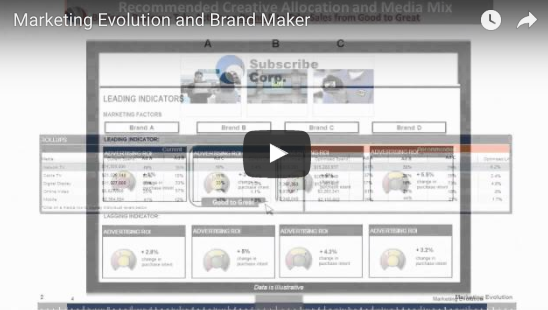What Can Marketers Do in a Recession?
Get the Omnichannel Marketer's Attribution Handbook

With the predicted recession looming on the horizon, marketers have the right to be worried. After all, marketing is often the first thing cut when businesses tighten their purse strings. But as we’ve learned in the past, cutting marketing budgets isn’t necessarily the right way to go.
Reducing marketing spend means fewer sales and less revenue, ultimately compounding the problem. In fact, according to marketing expert Stephen King, “Businesses that cut their advertising expenditures in a recessionary period lose no less in terms of profitability than those who actually increase spending by an average of 10 percent”.
So if reducing marketing spend is not the answer to getting through the recession, what is?
There are a few things marketers must keep in mind as we move into an area of economic uncertainty. Let’s take a look.
1. Do Not Stop Advertising
In Peter Steidl’s book, “Survive, Exploit, Disrupt: Action Guidelines for Marketing in a Recession”, he notes that companies who increased spending during a recession actually saw a 4.3% increase in profits compared to those that cut spending (0.8% increase).
Unfortunately, many companies don’t think that way. The knee-jerk instinct of many brands faced with a recession is to immediately cut marketing budgets and reduce media spend. It makes sense - less money coming in should mean less money going out.
But marketing is not a luxury, it’s a necessity. It’s as essential to brands as a utility like power or water. You need marketing to stay in business. Your brand also needs to attract new customers and stay at the forefront of established customers’ minds.
Following that fear-based instinct to cut as much spending as possible will have the opposite effect. Think beyond the recession and focus on what’s right for your business.
2. Analyze Your Tech Stack

Instead of cutting out the lights, so to speak, now is the time to take a look at the tools you currently use to determine which are not improving the bottom line or saving your organization money.
When evaluating your existing tech stack, you want to ask yourself the following:
- Are there certain tools that have duplicative efforts? Is one of these less valuable?
- Does the solution help or improve the business across multiple teams? For example, if a tool is so specialized it only performs one task, for one team, investing in it further might not be the best use of your budget as you look to cut costs.
- Can the solution reduce waste and provide savings while at the same time increasing desired marketing outcomes in the funnel?
Tech stacks can become bloated, making them a great place to look when cutting costs. As you evaluate your existing technology, lean toward solutions that reduce waste and improve marketing efforts. This is a “spend smarter, not harder” situation.
3. Lean Hard on ROI Analysis
How do you evaluate your tools, tech, and teams? By relying on your ROI analyses to direct your attention to the channels, tactics, creatives, partners, and campaigns that really drive awareness of your brand and, of course, revenue.
Keep in mind that gut feelings can only get you so far during this assessment. You may think you know what is and isn’t working and what is and isn’t getting you the most value for every dollar you spend. But you can’t really be sure -- not without the right data.
You need to pair your human experience with real data that provides value so you can double down on what’s working and scale back on what isn’t.
When in doubt, trust your ROI analysis.
4. Dive Deep Into a Test & Learn Approach

Learning from the past is one of the best ways to predict the future. It’s why we are continuously talking about unified measurement and omnichannel optimization.
Just like a recession is not the time to cut your advertising budget, it’s also not the time to cower down and stick to the status quo. If the pandemic taught us anything, it’s that new opportunities can arise from difficult situations.
Don't be afraid to test a messaging strategy, tactic strategy, or channel strategy. You don’t have to make dramatic changes or shift large amounts of dollars into something new. Start incrementally.
Study the data yielded from these small changes in order to make larger-scale updates with confidence. This data, and the results of your testing, will be the light that guides you through the recession.
5. Be Flexible, Nimble & Ready to Pivot
In a recession, or any unstable economic environment, flexibility and speed are crucial. How much can you adapt and how quickly? When the media plan your team created at the beginning of the year is thrown out the window by Q2, can you rise to the challenge of changing that plan on the fly? Can you restructure plans for today and for the future at the same time?
Agility and optimization will become extremely important as plans shift from yearly or quarterly planning models to more real-time monthly or even weekly models.
To stay lean and nimble, you need to understand how your online and offline channels work together. Channels are more connected than many marketers realize, and to institute these kinds of at-speed changes, you’re going to need to intimately understand how they interact.
Successful pivots rely on swinging all of your moving pieces in the same direction, all at once.
6. Go Back to the Basics
If the goal is to stay as lean, quick, and efficient as possible throughout the recession, now is the time to get back to the basics of marketing and invest in more affordable advertising methods. Here are a few to consider:
- Organic social media posts. Building your audience through organic posting, rather than paid advertisements, shows a desire to create and connect within a community, not just chase a sale.
- Focus on creating content. A successful content strategy is full of valuable and useful information – and spotlights your services or products. It also drives steady traffic to your website, from both new and established customers.
- Join or create Facebook groups. Groups are another place to access community and provide value to your target audience. Build loyalty by making your followers feel seen, heard, and as if they matter to you (because they do).
- Send emails to clients. New customers are always nice, but it’s your existing customer base that’s going to get you through the recession. Show these customers they matter, and that you’re there for them during this period of economic uncertainty. Send them direct, personalized email offers, discounts, or access to exclusive programs.
- Go live on Facebook or Instagram. Lives are a great way to interact with your followers and attract new ones. They’re free, and they can be structured however you like. Present new products or services, chat with a special guest, or just have a conversation with your customers (hello AMA!).
- Donate to local non-profit organizations. This doesn’t have to be money. Donate your time, products, or services to your community through a local non-profit to build connection, brand awareness, and loyalty.
Remember that marketing can take many forms and sometimes the basic (and low cost) forms work just as well.
The Goal Isn't Just Survival
With economic stress and uncertainty looming, it’s all too easy for marketers and brands to give in to fear and make panicked knee-jerk reactions. Don’t let this be you.
The right tech, tools, and partners will help you trim the fat and stay lean. Improve your ROI by optimizing with clear-sighted analytics, testing, and learning as you navigate not only this period of uncertainty but beyond.
The goal here isn’t just to survive through the coming recession – it’s to thrive.





















